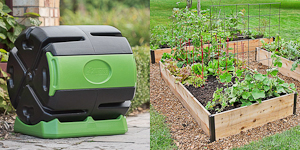- Home
- How to Make Organic Fertilizer
- Paramagnetic Rock Dust
Paramagnetic Rock Dust
in the Vegetable Garden
 Paramagnetic Rock Dust: A Little Goes a Long Way
Paramagnetic Rock Dust: A Little Goes a Long WayThe use of paramagnetic rock dust is gaining notoriety in cutting-edge organic farming these days. Why rock dust? And why only certain, specific rock dusts? What do they do, and can they be of help in the vegetable garden?
I’ve read quite a bit about this lately, because there does seem to be something wonderful going on here.
We can follow the lead of these biological farmers and use rock dusts in the vegetable garden to increase the health of our soils, improve the microbial ecosystem, and increase both the nutrition and yield of our vegetables.. So of course I have to share this with you!
The specific rock dust powders we’re interested in have two main qualities:
- they contain trace minerals in slow-release form
- they have paramagnetic properties
Trace Minerals from Deep In the Earth
The best rock dusts for our purposes are volcanic in origin. Magma deep in the earth is a sort of elemental soup, and when it is exuded through a volcano as lava or ash, it brings a host of broad spectrum minerals and elements up to the surface. There are volcanoes all over the planet, and when they erupt they often distribute ash over a wide area. Rivers that flow from volcanic regions also carry valuable volcanic silt, which is one reason why many river valleys have such fertile soil.
Over geologic time plant life slowly extracts and uses these minerals, which are then eaten by animals and people. In the modern developed world, because of sewage removal systems, these precious minerals don’t get cycled back into the soil - they go down rivers and out to sea. Our agricultural soils are being depleted of minerals, and our health is now suffering as a result.
For the minerals in volcanic rock dust to become available to plants, microbes are needed. Microbes exude acids which help degrade the rock particles into their component minerals, which can then be utilized by plants.
So rock dusts are a safe form of slow-release, trace mineral fertilizer. Microbes and plants work together in symbiotic relationships to extract the needed minerals from rock, making them available to animals and people. Using rock dusts (the finer the better, dust is best) in the vegetable garden will boost microbial growth, improve soil, and make our veggies more nutritious.
Paramagnetic Rock Dust
The other desirable quality of the best rock dust powders is that they are paramagnetic. I think you need to be a physicist to really understand what’s going on with magnetism and paramagnetism, but here’s what I think I understand so far about these forces. (I'll update this article as I learn more.)
What we generally think of as “magnetism” is ferromagnetism, which is the result of the unpaired electrons in a substance (like iron) lining up both with each other, and with an applied electromagnetic field. Remove the electromagnetic field, and the particles still remain aligned with each other, but (obviously) not the field.
Magnetic substances are repelled by magnetic fields. (I know, you’re thinking that two magnets themselves will be attracted to each other at one end and repelled at the other, but this is because of how their internal particles are aligned with each other. In the presence of an applied electromagnetic field, they are repelled.)
In a paramagnetic substance, however, the unpaired electrons line up only with the applied field and not with each other - so take the field away, and they no longer remain aligned. Paramagnetic substances are attracted to magnetic fields.
Paramagnetic substances exhibit another, related property: they are capable of receiving and absorbing energy from extremely low frequency radio waves (ELF). ELF is generated by lightning, and there are somewhere between 2,000 and 4,000 strikes per minute that occur around the globe. These lightning strikes charge the atmosphere with ELF energy.
Paramagnetic materials are capable of absorbing this energy, which they then emit as photons. That’s right, light.
Now paramagnetic rocks (and their powders) don’t glow in the dark in any way that the eyes can see, but the light emission can be measured by sensitive photon-emission instruments.
The German biophysicist Fritz-Albert Popp measured photon emissions from paramagnetic rock, and discovered something profound. When mixed with compost that was rich in microbes, the photon emission was amplified a hundredfold!
So mix paramagnetic rock dust with compost, leave it a few weeks (keeping it moist so the microbes can thrive), and then add it to your garden the next time you work the soil. It will make plants grow more extensive root systems, leading to better mineral uptake and more nutritious vegetables.
At this point I have to say that I don’t understand why the photon emission has such an effect on microbes and plant roots, but it does, and we can benefit from using paramagnetic rock dusts in our gardens without a full comprehension of why it works.
Help share the skills and spread the joy
of organic, nutrient-dense vegetable gardening, and please...
~ Like us on Facebook ~
Thank you... and have fun in your garden!
Affiliate Disclaimer
This website contains affiliate links to a few quality products I can genuinely recommend. I am here to serve you, not to sell you, and I do not write reviews for income or recommend anything I would not use myself. If you make a purchase using an affiliate link here, I may earn a commission but this will not affect your price. My participation in these programs allows me to earn money that helps support this site. If you have comments, questions or concerns about the affiliate or advertising programs, please Contact Me.Contact Us Page



